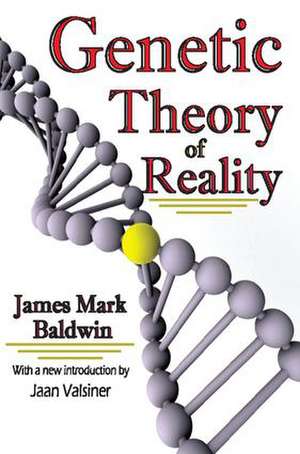Genetic Theory of Reality
Autor James Mark Baldwin, Jaan Valsineren Limba Engleză Paperback – 15 dec 2009
| Toate formatele și edițiile | Preț | Express |
|---|---|---|
| Paperback (1) | 475.11 lei 6-8 săpt. | |
| Taylor & Francis – 15 dec 2009 | 475.11 lei 6-8 săpt. | |
| Hardback (1) | 764.20 lei 6-8 săpt. | |
| Taylor & Francis – 12 oct 2017 | 764.20 lei 6-8 săpt. |
Preț: 475.11 lei
Nou
Puncte Express: 713
Preț estimativ în valută:
90.94€ • 93.71$ • 76.77£
90.94€ • 93.71$ • 76.77£
Carte tipărită la comandă
Livrare economică 03-17 martie
Preluare comenzi: 021 569.72.76
Specificații
ISBN-13: 9781412810852
ISBN-10: 141281085X
Pagini: 420
Dimensiuni: 152 x 229 x 22 mm
Greutate: 0.59 kg
Ediția:Revised
Editura: Taylor & Francis
Colecția Routledge
Locul publicării:Oxford, United Kingdom
ISBN-10: 141281085X
Pagini: 420
Dimensiuni: 152 x 229 x 22 mm
Greutate: 0.59 kg
Ediția:Revised
Editura: Taylor & Francis
Colecția Routledge
Locul publicării:Oxford, United Kingdom
Cuprins
Introduction to the Transaction Edition by Jaan Valsiner
Supplementary Commentary by Patrick Bateson
Preface
PART I: INTRODUCTION: GENETIC INTERPRETATION
CHAPTER 1: THE PROBLEM: GENETIC MORPHOLOGY
1. The Question of Interpretation
2. The Historical Problem
3. The Intrinsic Problem
4. Scheme of Treatment
CHAPTER II: INDIVIDUAL INTERPRETATION
1. The Nature of Interpretation
2. Interpretation as an Organisation of Interests
3. Interpretation as the Social Organisation of Interests
4. The Progression of Interpretation
5. The Realities as Interpreted
CHAPTER III: THE PARALELLISM BETWEEN INDIVIDUAL AND RACIAL INTERPRETATION
1. The Question of Racial Interpretation
2. Racial Interpretation as Organised Social Interest
3. The Stages of Interpretation
PART II: DEVELOPMENT OF INTERPRETATION
CHAPTER IV: EARLY RACIAL INTERPRETATION: ITS PRELOGICAL CHARACTER
1. General Character of Early Racial Interpretation
2. The Social Character of Early Racial Interpretation
3. The a-Dualistic Character of Early Racial Interpretation
4. The Relatively a-Logical Character of Early Racial Interpretation
CHAPTER V: EARLY RACIAL INTERPRETATION: ITS POSITIVE CHARACTER
1. The Social Organisation of Primitive Interest
2. The Affective Nature of Primitive Generalisation
3. Imitation and Ejection in Primitive Thought
4. Primjt1ve Animism and Mysticism
5. The Rise of Mediate or Logical Interpretation
CHAPTER VI: THE RELIGIOUS INTERPRETATION
1. The Religious Interest
2. The Religious Experience
3. The Religious Object: its Personal Meaning
4. The Religious Object: its Ideal Meaning
5. The Development of the Religious Meaning: its Logic
6. The Social Character of Religion
CHAPTER VII: RELIGIOUS REALITY AND RELIGIOUS NEGATION
1. The Religious Object as Existing
2. The Union of Ideal and Actual in Religious Reality
3. The Religious Antinomy
4. Religious Negation: I. the Non-Religious or Secular
5. Religious Negation: II. The Irreligious or Profane
6. Profane Reality: the Arch-Devil
7. The Philosophy of Religion: Religion as Organ of Value
CHAPTER VIII: LOGICAL INTERPRETATION
1. The Transition to Logic: the Role of Imagination
2. The Problem of Reflection
3. Logical Theories: Scheme of Treatment
CHAPTER IX: LOGICAL INTERPRETATION: MEDIATION THEORIES
1. Actuality Theories: Intellectualism
2. Examination of Intellectualism
3. Ideality Theories: Voluntarism
4. Examination of Voluntarism
CHAPTER X: IMMEDIATE THEORIES: I. THOSE BASED ON THE PRIMITIVE AND THE TRANSCENDENT
1. Their Basis: Immediacy
2. Theories Based on Primitive Immediacy (Primitive Mysticism, Subjectivism, Idealism)
3. Theories based on the Immediacy of Completion or Transcendence (Intuitionism, Dogmatic Spiritualism, Criticism, Absolutism)
4. Results
CHAPTER XI: IMMEDIATE THEORIES OF REALITY: II. THOSE BASED ON THE IMMEDIACY OF SYNTHESIS
1. The Immediacy of Synthesis
2. The Use of the Immediacy of Personality (Higher Mysticism, Super-Personal Theories)
3. The Synthesis of Feeling (Platonic Love, Constructive Affectivism, Faith Philosophy)
4. The Æsthetic Synthesis (Aristotle, Kant, Schelling)
CHAPTER XII: RESULTS OF THE HISTORICAL SURVEY: THE DEMAND FOR AN INTRINSIC SYNTHESIS
1. The Presupposition of Truth and the Postulate of Value
2. The Fruitful Method, Genetic
PART III: JESTHETIC IMMEDIACY
CHAPTER XIII: THE INTRINSIC SYNTHESIS, ÆSTHETIC
1. The First Step: Imaginative Semblance
2. The Æsthetic Interest Synthetic in the Sense of Intrinsic or Autotelic
3. The Æsthetic Object Synthetic in the Sense of a-Dualistic
4. The Æsthetic Ideal Synthetic in the Sense of Syntelic
5. The Æsthetic Reality Inclusive and Privative
6. The Æsthetic Reality a Synthesis of Universal and Singular
CHAPTER XIV: THE ÆsTHETIC INTERPRETATION
1. Æsthetic Realisation as Reconciliation of the Presupposition and the Postulate
2. Æsthetic Realisation as Reconciliation of Actuality and Ideality
3. Æsthetic Realisation as Reconciliation of Freedom and Necessity
4. Æsthetic Realisation an Immediacy both of Reconciliation and of Fulfilment
5. Æsthetic Intuition a Union of Theoretical and Practical-and More
6. Æsthetic Reason and Absolute Beauty
PART IV: CONCLUSIONS
CHAPTER XV: PANCALISM: A THEORY OF REALITY
1. What Reality Must Mean
2. Sorts of Relativity
3. The Æsthetic Content a Non-Relative Whole
4. The Æsthetic, a Non-Relative Mode
5. The Æsthetic, a Non-Relative Acceptance
6. The Æsthetic Non-Relative as Respects the Relation of Knower and Known
7. The Knower and his Experience: Pancalism
CHAPTER XVI: COROLLARIES
1. The Nature of Reality
2. The Only Alternative-Pluralism
3. Pancalism, a Constructive Affectivism
Glossary of Terms
Appendix A
Appendix B
Appendix C
Index
Supplementary Commentary by Patrick Bateson
Preface
PART I: INTRODUCTION: GENETIC INTERPRETATION
CHAPTER 1: THE PROBLEM: GENETIC MORPHOLOGY
1. The Question of Interpretation
2. The Historical Problem
3. The Intrinsic Problem
4. Scheme of Treatment
CHAPTER II: INDIVIDUAL INTERPRETATION
1. The Nature of Interpretation
2. Interpretation as an Organisation of Interests
3. Interpretation as the Social Organisation of Interests
4. The Progression of Interpretation
5. The Realities as Interpreted
CHAPTER III: THE PARALELLISM BETWEEN INDIVIDUAL AND RACIAL INTERPRETATION
1. The Question of Racial Interpretation
2. Racial Interpretation as Organised Social Interest
3. The Stages of Interpretation
PART II: DEVELOPMENT OF INTERPRETATION
CHAPTER IV: EARLY RACIAL INTERPRETATION: ITS PRELOGICAL CHARACTER
1. General Character of Early Racial Interpretation
2. The Social Character of Early Racial Interpretation
3. The a-Dualistic Character of Early Racial Interpretation
4. The Relatively a-Logical Character of Early Racial Interpretation
CHAPTER V: EARLY RACIAL INTERPRETATION: ITS POSITIVE CHARACTER
1. The Social Organisation of Primitive Interest
2. The Affective Nature of Primitive Generalisation
3. Imitation and Ejection in Primitive Thought
4. Primjt1ve Animism and Mysticism
5. The Rise of Mediate or Logical Interpretation
CHAPTER VI: THE RELIGIOUS INTERPRETATION
1. The Religious Interest
2. The Religious Experience
3. The Religious Object: its Personal Meaning
4. The Religious Object: its Ideal Meaning
5. The Development of the Religious Meaning: its Logic
6. The Social Character of Religion
CHAPTER VII: RELIGIOUS REALITY AND RELIGIOUS NEGATION
1. The Religious Object as Existing
2. The Union of Ideal and Actual in Religious Reality
3. The Religious Antinomy
4. Religious Negation: I. the Non-Religious or Secular
5. Religious Negation: II. The Irreligious or Profane
6. Profane Reality: the Arch-Devil
7. The Philosophy of Religion: Religion as Organ of Value
CHAPTER VIII: LOGICAL INTERPRETATION
1. The Transition to Logic: the Role of Imagination
2. The Problem of Reflection
3. Logical Theories: Scheme of Treatment
CHAPTER IX: LOGICAL INTERPRETATION: MEDIATION THEORIES
1. Actuality Theories: Intellectualism
2. Examination of Intellectualism
3. Ideality Theories: Voluntarism
4. Examination of Voluntarism
CHAPTER X: IMMEDIATE THEORIES: I. THOSE BASED ON THE PRIMITIVE AND THE TRANSCENDENT
1. Their Basis: Immediacy
2. Theories Based on Primitive Immediacy (Primitive Mysticism, Subjectivism, Idealism)
3. Theories based on the Immediacy of Completion or Transcendence (Intuitionism, Dogmatic Spiritualism, Criticism, Absolutism)
4. Results
CHAPTER XI: IMMEDIATE THEORIES OF REALITY: II. THOSE BASED ON THE IMMEDIACY OF SYNTHESIS
1. The Immediacy of Synthesis
2. The Use of the Immediacy of Personality (Higher Mysticism, Super-Personal Theories)
3. The Synthesis of Feeling (Platonic Love, Constructive Affectivism, Faith Philosophy)
4. The Æsthetic Synthesis (Aristotle, Kant, Schelling)
CHAPTER XII: RESULTS OF THE HISTORICAL SURVEY: THE DEMAND FOR AN INTRINSIC SYNTHESIS
1. The Presupposition of Truth and the Postulate of Value
2. The Fruitful Method, Genetic
PART III: JESTHETIC IMMEDIACY
CHAPTER XIII: THE INTRINSIC SYNTHESIS, ÆSTHETIC
1. The First Step: Imaginative Semblance
2. The Æsthetic Interest Synthetic in the Sense of Intrinsic or Autotelic
3. The Æsthetic Object Synthetic in the Sense of a-Dualistic
4. The Æsthetic Ideal Synthetic in the Sense of Syntelic
5. The Æsthetic Reality Inclusive and Privative
6. The Æsthetic Reality a Synthesis of Universal and Singular
CHAPTER XIV: THE ÆsTHETIC INTERPRETATION
1. Æsthetic Realisation as Reconciliation of the Presupposition and the Postulate
2. Æsthetic Realisation as Reconciliation of Actuality and Ideality
3. Æsthetic Realisation as Reconciliation of Freedom and Necessity
4. Æsthetic Realisation an Immediacy both of Reconciliation and of Fulfilment
5. Æsthetic Intuition a Union of Theoretical and Practical-and More
6. Æsthetic Reason and Absolute Beauty
PART IV: CONCLUSIONS
CHAPTER XV: PANCALISM: A THEORY OF REALITY
1. What Reality Must Mean
2. Sorts of Relativity
3. The Æsthetic Content a Non-Relative Whole
4. The Æsthetic, a Non-Relative Mode
5. The Æsthetic, a Non-Relative Acceptance
6. The Æsthetic Non-Relative as Respects the Relation of Knower and Known
7. The Knower and his Experience: Pancalism
CHAPTER XVI: COROLLARIES
1. The Nature of Reality
2. The Only Alternative-Pluralism
3. Pancalism, a Constructive Affectivism
Glossary of Terms
Appendix A
Appendix B
Appendix C
Index
Notă biografică
James Mark Baldwin, Jaan Valsiner
Descriere
Shows that James Mark Baldwin's Genetic Theory of Reality demonstrates how human beings are in their nature social beings, establishes an alternative conceptualization of evolutionary theory, and formulates a system of developmental logic, all of which serve as the foundation for developmental psychology as a whole.


























